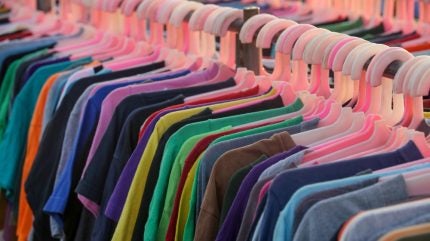
The global secondhand apparel market will be worth $350bn by 2028 and will comprise 10% of the fashion market worldwide by 2025.
The Resale Report, written for online fashion thrift store ThredUp by data research company GlobalData reveals the sector grew 15 times faster than the broader retail clothing sector in 2023. With 163 brands owning resale shops in 2023, retailers are already embracing the opportunities presented by resale.
GlobalData retail analyst Neil Saunders tells Just Style: “One of the reasons secondhand is growing so rapidly is because the market is driven by a range of factors rather than one single factor.
“There is a value for money angle, which has become more important at a time of heavy inflation. There’s a sustainability angle, which makes many favourably predisposed to the circular economy, and there is an individuality angle where consumers value the uniqueness of the products available secondhand.”
What is driving growth in the secondhand sector?
Saunders predicts that, between 2023 and 2028, the global secondhand market will grow by 77.8%. He expects that Asia’s resale sector will see the fastest growth and will be worth $150bn by 2028, making it the largest global market followed by Europe.
Asia’s market is still currently in its infancy, but the increasing number of online resale platforms is driving consumer engagement in the sector. Where resale platforms such as Depop, Vinted and ThredUp have found success in the West, resale platforms such as Plum (also know as Hongbulin) and DeWu are seeking success in the Asian market.
Online shopping for secondhand fashion will continue to grow, as Gen Z and Millennial consumers favour digital retail over physical. The report found that 51% of Gen Z shoppers prefer to buy resale items online, a figure beaten only by Millennials, of whom 55% prefer purchasing secondhand apparel online.
Individualism and self-expression are driving factors among these consumers. However, consumers more broadly will look to prioritise value in future purchases, according to the report, which found that 59% of shoppers would prefer not to make a purchase if they can’t find a “good” deal.
“Younger shoppers – Gen Z and Millennials – will contribute the most growth over the next five years. Both generations are very interested in sustainability and enjoy secondhand shopping. Gen Z are also seeing their spending power increase, which will help boost their spending on resale,” says Saunders.
Secondhand style: the solution to fashion’s sustainability problem?
The report also finds that 62% of retail executives believe their customers care about brand sustainability. Advancement of sustainability goals was a reason for 77% of responding brands to consider resale, making it the third most popular reason after acquiring more customers (89%) and generating revenue (85%).
Saunders suggests that resale offers brands an opportunity to connect with customers.
“Brands should consider resale as it is a growth segment, and it’s a part of the market consumers are interested in and engaging with,” he says. “Secondhand also helps brands to showcase their sustainability credentials, which can be an important differentiator.”
The report also considers the potential of government involvement in the secondhand sector. It notes that 44% of consumers see circular textile policy as a non-partisan issue, and 42% believe the government should take legislative action to promote sustainable fashion.
ThredUp CEO James Reinhart says: “The global secondhand apparel market continues to burgeon – a testament to the intrinsic value shoppers find in the secondhand experience and proof of the seismic shift towards a more circular fashion ecosystem. As we celebrate this progress, we also recognise the powerful role the government can play in accelerating the transition to a more sustainable future for fashion …
“Until fashion is no longer one of the most damaging sectors of the global economy, we will continue to advocate for the government to help drive adoption and behaviour change in fashion.”



